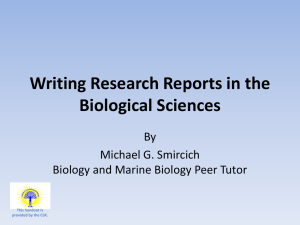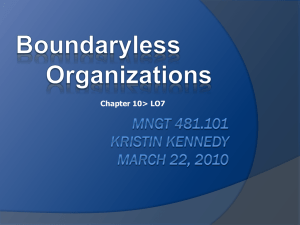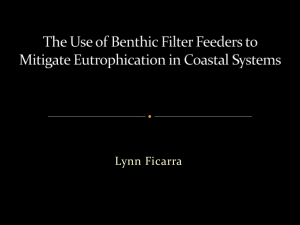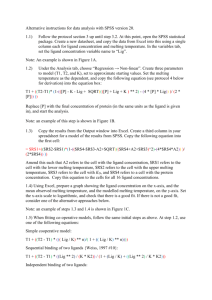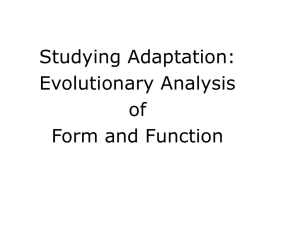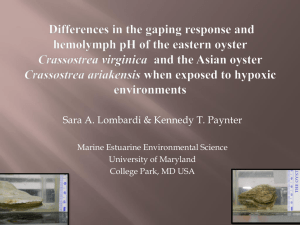Electronic Supplementary Material
advertisement
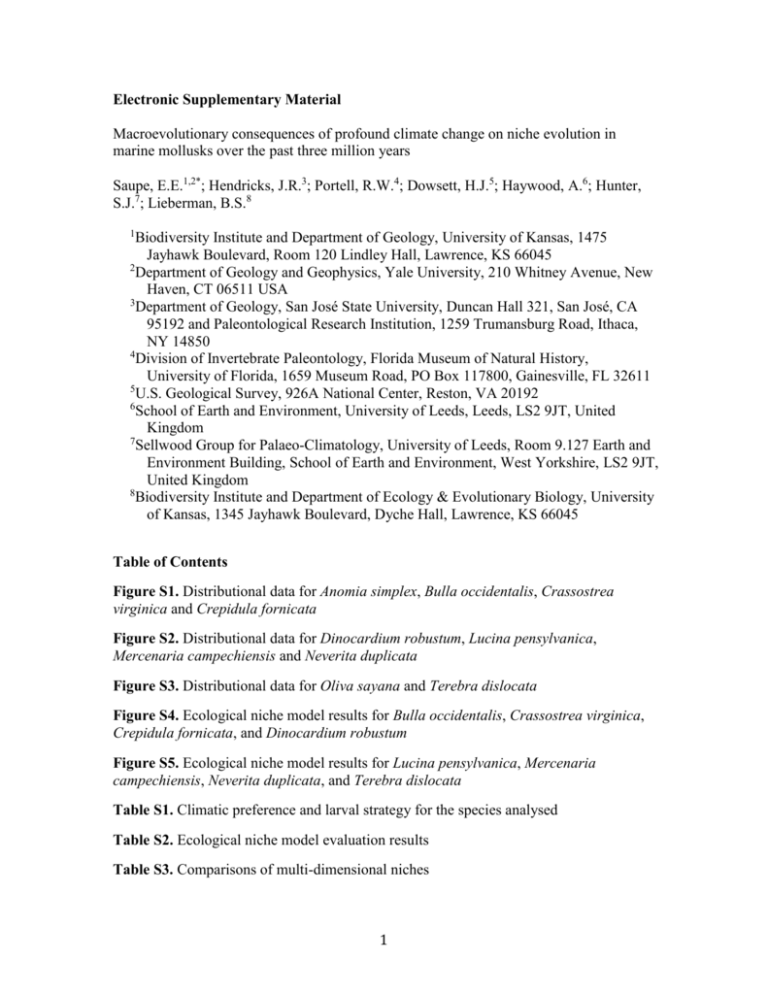
Electronic Supplementary Material Macroevolutionary consequences of profound climate change on niche evolution in marine mollusks over the past three million years Saupe, E.E.1,2*; Hendricks, J.R.3; Portell, R.W.4; Dowsett, H.J.5; Haywood, A.6; Hunter, S.J.7; Lieberman, B.S.8 1 Biodiversity Institute and Department of Geology, University of Kansas, 1475 Jayhawk Boulevard, Room 120 Lindley Hall, Lawrence, KS 66045 2 Department of Geology and Geophysics, Yale University, 210 Whitney Avenue, New Haven, CT 06511 USA 3 Department of Geology, San José State University, Duncan Hall 321, San José, CA 95192 and Paleontological Research Institution, 1259 Trumansburg Road, Ithaca, NY 14850 4 Division of Invertebrate Paleontology, Florida Museum of Natural History, University of Florida, 1659 Museum Road, PO Box 117800, Gainesville, FL 32611 5 U.S. Geological Survey, 926A National Center, Reston, VA 20192 6 School of Earth and Environment, University of Leeds, Leeds, LS2 9JT, United Kingdom 7 Sellwood Group for Palaeo-Climatology, University of Leeds, Room 9.127 Earth and Environment Building, School of Earth and Environment, West Yorkshire, LS2 9JT, United Kingdom 8 Biodiversity Institute and Department of Ecology & Evolutionary Biology, University of Kansas, 1345 Jayhawk Boulevard, Dyche Hall, Lawrence, KS 66045 Table of Contents Figure S1. Distributional data for Anomia simplex, Bulla occidentalis, Crassostrea virginica and Crepidula fornicata Figure S2. Distributional data for Dinocardium robustum, Lucina pensylvanica, Mercenaria campechiensis and Neverita duplicata Figure S3. Distributional data for Oliva sayana and Terebra dislocata Figure S4. Ecological niche model results for Bulla occidentalis, Crassostrea virginica, Crepidula fornicata, and Dinocardium robustum Figure S5. Ecological niche model results for Lucina pensylvanica, Mercenaria campechiensis, Neverita duplicata, and Terebra dislocata Table S1. Climatic preference and larval strategy for the species analysed Table S2. Ecological niche model evaluation results Table S3. Comparisons of multi-dimensional niches 1 Figure S1. Distributional data for Anomia simplex, Bulla occidentalis, Crassostrea virginica and Crepidula fornicata. Three time slices are represented: mid-Pliocene Warm Period (mPWP; ~3.1 Ma), Last Interglacial (LIG; ~ 130 Ka), and present-day (PI). 2 Figure S2 | Distributional data for Dinocardium robustum, Lucina pensylvanica, Mercenaria campechiensis and Neverita duplicata. Three time slices are represented: mid-Pliocene Warm Period (mPWP; ~3.1 Ma), Last Interglacial (LIG; ~ 130 Ka), and present-day (PI). 3 Figure S3 | Distributional data for Oliva sayana and Terebra dislocata. Three time slices are represented: mid-Pliocene Warm Period (mPWP; ~3.1 Ma), Last Interglacial (LIG; ~ 130 Ka), and present-day (PI). 4 Figure S4 | Ecological niche model results for Bulla occidentalis, Crassostrea virginica, Crepidula fornicata, and Dinocardium robustum. Binary and continuous predictions are presented, with binary predictions thresholded using the mean suitability value from the continuous output. For the binary predictions, yellow=suitable and dark blue=unsuitable, whereas for the continuous predictions, darker greys indicate higher suitability. Note that the modeled shorelines do not match the continental shorelines because of the nature of our GCM data and the need to capture the higher sea levels characteristic of the mid-Pliocene Warm Period. 5 Figure S5 | Ecological niche model results for Lucina pensylvanica, Mercenaria campechiensis, Neverita duplicata, and Terebra dislocata. Binary and continuous predictions are presented, with binary predictions thresholded using the mean suitability value from the continuous output. For the binary predictions, yellow=suitable and dark blue=unsuitable, whereas for the continuous predictions, darker greys indicate higher suitability. Note that the modeled shorelines do not match the continental shorelines because of the nature of our GCM data and the need to capture the higher sea levels characteristic of the mid-Pliocene Warm Period. 6 Table S1 | Climatic preference and larval strategy for the species analysed. Distributional data are shown for each time slice: mid-Pliocene Warm Period (mPWP; ~3.1 Ma), Last Interglacial (LIG; ~ 130 Ka), and present-day (PI). The “all” column indicates the total number of distributional records for each time slice/species, and the “unique” column specifies the spatially explicit distributional records used for modelling. Gastropoda Bivalvia Species Anomia simplex Crassostrea virginica Dinocardium robustum Lucina pensylvanica Mercenaria campechiensis Bulla occidentalis Crepidula fornicata Neverita duplicata Oliva sayana Terebra dislocata Climatic Zone Larval Strategy Temperate—Tropical Temperate—Tropical Subtropical—Tropical Tropical Subtropical—Tropical Tropical Temperate—Tropical Temperate—Tropical Tropical Subtropical—Tropical Planktonic Planktonic Planktonic Benthic Planktonic Planktonic Planktonic Planktonic Planktonic Benthic 7 Distributional Data mPWP LIG PI All Unique All Unique All Unique 219 13 85 15 96 31 42 7 24 10 62 37 59 7 46 11 74 22 127 7 29 8 79 37 198 14 94 12 70 24 82 6 60 9 191 58 157 16 31 10 103 42 134 16 54 14 88 28 76 9 28 8 81 25 58 9 37 13 89 20 Table S2 | Significance testing of ecological niche models for each species and time slice. P-values on the niche models were obtained using a jackknife procedure for time slices/species that had < 25 occurrence points (single rows), and with a partial Receiver Operating Characteristic Analysis (partial ROC) for time slices/species that had > 25 occurrence points. All models were statistically significant. Bivalvia Species Time Slice Set Gastropoda AUC Ratio/ P-value Success Rate mPWP NA 0.92 LIG NA 0.93 1 1.81 Anomia simplex 2 1.81 PI 3 1.82 4 1.31 5 1.19 mPWP NA 0.71 LIG NA 0.90 1 1.29 Crassostrea virginica 2 1.77 PI 3 1.65 4 1.52 5 1.79 mPWP NA 0.86 Dinocardium robustum LIG NA 0.91 PI NA 0.95 mPWP NA 0.86 LIG NA 0.75 1 1.61 Lucina pensylvanica 2 1.59 PI 3 1.54 4 1.91 5 1.76 mPWP NA 0.93 Mercenaria LIG NA 0.92 campechiensis PI NA 0.96 0.00 0.00 0.00 0.00 0.00 0.03 0.05 0.00 0.00 0.01 0.00 0.00 0.00 0.00 0.00 0.00 0.00 0.00 0.00 0.00 0.00 0.00 0.00 0.00 0.00 0.00 0.00 Species Bulla occidentalis Crepidula fornicata Neverita duplicata Oliva sayana Terebra dislocata 8 Time Slice Set AUC Ratio/ P-value Success Rate mPWP NA 0.50 LIG NA 0.89 1 1.53 2 1.18 PI 3 1.61 4 1.59 5 1.22 mPWP NA 0.88 LIG NA 0.90 1 1.79 2 1.20 PI 3 1.20 4 1.78 5 1.26 mPWP NA 0.88 LIG NA 0.93 1 1.82 2 1.70 PI 3 1.88 4 1.90 5 1.57 mPWP NA 0.89 LIG NA 0.88 PI NA 0.96 mPWP NA 0.78 LIG NA 0.92 PI NA 0.95 0.00 0.00 0.00 0.04 0.00 0.00 0.02 0.00 0.00 0.00 0.02 0.04 0.00 0.03 0.00 0.00 0.00 0.00 0.00 0.00 0.00 0.00 0.00 0.00 0.00 0.00 0.00 Table S3 | Comparisons of multi-dimensional niches. P-values for multi-dimensional niche comparison tests (1) using a PCA applied to all six environmental variables; (2) using raw average bottom temperature and maximum surface temperature; and (3) using ENMTools on projections of ecological niche models. Bold values indicate nonsignificant results. All significant results (P<0.05) indicate niches are statistically more similar than expected given the environmental background of the time slices, except for the result with the asterisk, which indicates this niche comparison was statistically dissimilar. Note that it is possible for two niches to be more similar than expected based on the environment available for one time slice, but less similar than expected based on the environment available for the other. For tests using a PCA applied to the three most important environmental variables, see Table 1 in the main manuscript. Species/Comparison mPWP–LIG LIG–mPWP PI–LIG LIG–PI mPWP–PI PI–mPWP Gastropoda Bivalvia Environmental comparison: p-values for tests using PCA on all 6 variables Anomia simplex 0.06 0.00 0.00 0.00 0.04 0.00 Crassostrea virginica 0.05 0.01 0.00 0.00 0.03 0.00 Dinocardium robustum 0.32 0.00 0.00 0.00 0.01 0.00 Lucina pensylvanica 0.16 0.00 0.09 0.00 0.14 0.00 Mercenaria campechiensis 0.15 0.00 0.00 0.00 0.06 0.00 Bulla occidentalis 0.11 0.00 0.00 0.00 0.16 0.00 Crepidula fornicata 0.11 0.00 0.01 0.00 0.01 0.01 Neverita duplicata 0.09 0.00 0.00 0.00 0.05 0.00 Oliva sayana 0.12 0.00 0.00 0.00 0.03 0.00 Terebra dislocata 0.06 0.01 0.00 0.00 0.01 0.00 Gastropoda Bivalvia Environmental comparison: p-values for tests using raw temperature variables Anomia simplex <0.05 <0.05 <0.05 <0.05 <0.05 <0.05 Crassostrea virginica <0.05 NS <0.05 <0.05 <0.05 NS Dinocardium robustum <0.05 <0.05 <0.05 <0.05 <0.05 <0.05 Lucina pensylvanica <0.05 <0.05 <0.05 <0.05 <0.05 <0.05 Mercenaria campechiensis <0.05 <0.05 <0.05 <0.05 <0.05 <0.05 Bulla occidentalis NS NS <0.05 <0.05 <0.05 NS Crepidula fornicata <0.05 <0.05 <0.05 <0.05 <0.05 <0.05 Neverita duplicata <0.05 <0.05 <0.05 <0.05 <0.05 <0.05 Oliva sayana <0.05 <0.05 <0.05 <0.05 <0.05 NS Terebra dislocata <0.05 <0.05 <0.05 <0.05 <0.05 <0.05 Gastropoda Bivalvia Geographic comparison: p-values for tests using ecological niche models Anomia simplex <0.05 <0.05 <0.05 <0.05 <0.05 <0.05 Crassostrea virginica NS <0.05 <0.05 <0.05 <0.05 <0.05 Dinocardium robustum <0.05 <0.05 <0.05 <0.05 <0.05 <0.05 Lucina pensylvanica <0.05 <0.05 <0.05 <0.05 <0.05 NS Mercenaria campechiensis <0.05 <0.05 <0.05 <0.05 <0.05 <0.05 Bulla occidentalis <0.05* <0.05 <0.05 <0.05 <0.05 NS Crepidula fornicata <0.05 <0.05 <0.05 <0.05 <0.05 <0.05 Neverita duplicata <0.05 <0.05 <0.05 <0.05 <0.05 <0.05 Oliva sayana <0.05 <0.05 <0.05 <0.05 <0.05 <0.05 Terebra dislocata <0.05 <0.05 <0.05 <0.05 <0.05 <0.05 9
